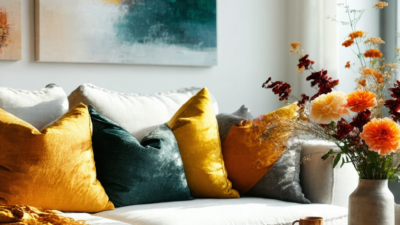The Art of Minimalist Living: How to Achieve a Timeless Home Decor
When it comes to home decor, the minimalist approach has become more than just a trend—it’s a lifestyle. By embracing simplicity and functionality, you can create a space that feels both modern and calming. But where do you start? Let’s explore the key elements of minimalist living and how you can incorporate them into your home.
What is Minimalist Living?
Minimalist living is about decluttering your space and focusing on what truly matters. It’s not just about having less; it’s about creating a harmonious environment that reflects your personal style and values. This approach encourages you to make intentional choices, whether you’re furnishing a room or choosing decor items.
Benefits of Minimalist Home Decor
Adopting a minimalist lifestyle can have numerous benefits:
- Reduces stress and anxiety: A clutter-free space promotes mental clarity and peace of mind.
- Saves time: Less stuff means less cleaning and maintenance, giving you more time to enjoy your home.
- Enhances functionality: Minimalist designs prioritize practicality, making your space more efficient and user-friendly.
Key Elements of Minimalist Design
To achieve a minimalist aesthetic in your home, focus on these essential components:
1. Neutral Color Palette
Stick to neutral tones like beige, white, gray, and soft pastels. These colors create a calming atmosphere and allow other elements to stand out. Consider using a single accent color sparingly to add interest without overwhelming the space.
2. Clean Lines
Straight lines and simple shapes are hallmarks of minimalist design. Opt for furniture with clean edges and avoid ornate details that can make a room feel busy. For example, choose a sleek, low-profile sofa or a table with smooth surfaces.
3. Natural Light
Maximize natural light to create an open, airy feel. Use sheer curtains or avoid heavy drapes altogether to let sunlight flow freely into your space. Large windows can also serve as a design element, framing views of nature and bringing the outside in.
4. Minimalist Furniture
Pick furniture that serves multiple purposes or fits seamlessly into the room’s layout. For instance, an ottoman with storage space can double as seating and a place to keep extra blankets. Ensure each piece is both functional and visually appealing.
5. Edit Everything
Simplify your decor by editing everything in your space. Keep only items that serve a purpose or hold sentimental value. Use storage solutions like open shelving, baskets, or bins to organize without adding visual clutter.
Tips for Achieving Minimalist Decor
Transitioning to a minimalist home doesn’t have to be overwhelming. Here are some actionable tips:
- Start small: Begin with one room or even one corner of your space. As you see the positive impact, gradually apply the principles throughout your home.
- Purge unnecessary items: Hold a yard sale, donate to charity, or recycle items you no longer need. This step is crucial for creating space and reducing visual clutter.
- Invest in quality: Instead of buying multiple inexpensive pieces, invest in high-quality furniture and decor that will last. A well-crafted piece can elevate your space while requiring fewer additions over time.
- Add texture: Use throws, rugs, or textured wall art to add depth without adding clutter. This technique helps maintain a minimalist feel while keeping the space inviting.
Common Mistakes to Avoid
While minimalism offers many benefits, it’s easy to go overboard. Here are some common pitfalls to avoid:
- Over-purging: Don’t remove everything at once. Keep functional items and decor that bring joy or serve a purpose.
- Ignoring personal style: Minimalism is versatile, so don’t shy away from adding elements that reflect your personality, such as artwork or meaningful objects.
- Neglecting functionality: While aesthetics are important, ensure your space remains practical. Choose furniture and decor that serve a clear purpose beyond just looking good.
Final Thoughts
A minimalist home decor is more than just a trend—it’s a way of life that promotes simplicity, functionality, and inner peace. By focusing on clean lines, neutral colors, and intentional design choices, you can create a space that feels both modern and calming. Remember, minimalism is about subtracting the unnecessary to make room for what truly matters: your well-being and enjoyment of your home.
Ready to embark on your minimalist journey? Start small, edit ruthlessly, and embrace the beauty of simplicity. Your future self will thank you!





